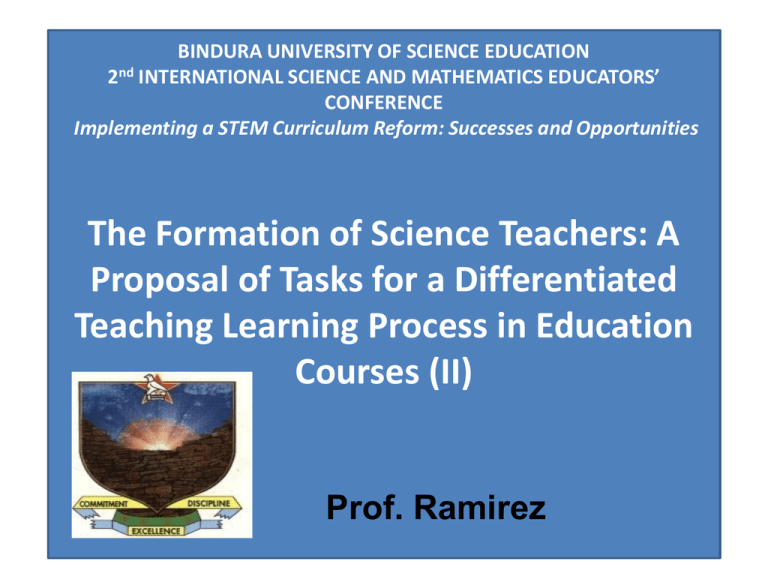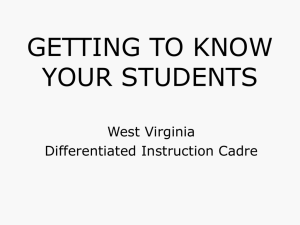The Formation of Science Teachers
advertisement

BINDURA UNIVERSITY OF SCIENCE EDUCATION 2nd INTERNATIONAL SCIENCE AND MATHEMATICS EDUCATORS’ CONFERENCE Implementing a STEM Curriculum Reform: Successes and Opportunities The Formation of Science Teachers: A Proposal of Tasks for a Differentiated Teaching Learning Process in Education Courses (II) Prof. Ramirez CURRENT SITUATION THEORETICAL BACKGROUND Learning Styles Multiple Intelligence Theory Differentiated Instruction Task based Teaching Every student and teacher deserves to be treated with RESPECT. Every student should have an opportunity to reach his or her individual potential. Every student should master specific basic skills WE MUST EXPLORE TO ACCOMMODATE INDIVIDUAL DIFFERENCES IN THE CLASSROOM AND TO GIVE ALL STUDENTS THE BEST OPPORTUNITIES FOR SUCCESS LEARNERS DO NOT FIT A SINGLE MOULD Students differ in many respects Individual learning needs Interests Learning preferences Level or pace of learning Skills development Personal experiences(previous knowledge) Culture, family and socioeconomic background, etc. Learners bring their OWN individual approach, talents and interests to the learning situation LEARNING STYLE Preferred way of learning, natural inclination towards learning If identified, teaching and learning experiences can be provided for an effective learning Major types of learners Visual Auditory Tactile /kinaesthetic (Gardner, 1985) OTHER CLASSIFICATIONS OF LEARNERS •Innovative learners •Analytic learners •Common sense learners • Dynamic learners •Avoidant students • Participative students • Competitive students • Collaborative students •Dependent students -INNOVATIVE LEARNERS: they look for personal meaning while learning, draw on their values while learning, enjoy social interaction, cooperate and want to make the world a better place (Gardner & McCarthy, 1990). -ANALYTIC LEARNERS: they want to develop intellectually while learning, draw on facts while learning, they are patient and reflective, they want to know "important things" and to add to the world's knowledge (Gardner & McCarthy, 1990). -COMMON SENSE LEARNERS: they want to find solutions, they value things if they are useful, they are kinaesthetic, they are practical and straightforward, they want to make things happen (Gardner & McCarthy, 1990). -DYNAMIC LEARNERS: they look for hidden possibilities, judge things by gut reactions, synthesize information from different sources, and are enthusiastic and adventurous. (Gardner & McCarthy, 1990). -AVOIDANT STUDENTS tend to be at the lower end of the grade distribution. They tend to have high absenteeism, they organize their work poorly, and take little responsibility for their learning. (Reichmann & Grasha, 1974). -PARTICIPATIVE STUDENTS are characterized as willing to accept responsibility for selflearning and relate well to their peers. (Reichmann & Grasha, 1974). COMPETITIVE STUDENTS are described as suspicious of their peers leading to competition for rewards and recognition. (Reichmann & Grasha, 1974). - DEPENDENT STUDENTS typically become frustrated when facing new challenges not directly addressed in the classroom. (Reichmann & Grasha, 1974) - -COLLABORATIVE STUDENTS enjoy working in harmony with their peers (Reichmann & Grasha, 1974). Theory of multiple intelligences Linguistic -Body-kinaesthetic -Spatial -Logical-mathematical -Musical -Interpersonal -Intrapersonal -Naturalistic Intelligences A classroom that utilizes differentiated instruction is a LEARNERRESPONSIVE, TEACHERFACILITATED classroom Lessons may be on INQUIRY BASED, PROBLEM BASED, TASK BASED and PROJECT BASED instruction TASK BASED TEACHING TYPES OF TASKS Role plays Simulation Solution to problems Debate Mini-lectures Round table Oral report Presentation of the results of research works Games PROPOSAL OF TASKS to Be Developed in Education Courses I-DEBATE (Management of Science Education, Management of Learning in Tertiary Education, Sociology of Education) (Interpersonal, Verbal/ Linguistic, Logical/ Mathematical Intelligences. Social, Verbal, Logical Learning Styles. Innovative, Analytic, Participative, Dynamic, Common Sense, Collaborative, Kinaesthetic Learners) Monalisa Smile is a USA film of 2003 that tells the story of Kathy, a teacher of History of Arts who is living her first experience teaching at a very conservative female school in California, during the summer of 1953. You are going to watch a 17 minutes fragment in order to discuss the answers to the following questions with your peers: -Is the situation related to issues of management of education? -If so, which are the positive and negative aspects you were able to determine? -If the answer is NO, support it Learners are given 20 minutes for the analysis of the answers and some of them are asked to write down the aspects determined. Afterwards, there should be a whole class activity where one learner goes to the board to write in two columns the positive and negative aspects, each of them numbered. Later the classroom is divided into two teams. Some cards with the topics of the course outline are distributed between the two teams and they are asked to predict the correspondence between the topics of the course outline and the aspects analysed, derived from the film. A learner from each team is asked to jot down the results and to prepare a poster in their free time. The posters are to be hung in the classroom walls and at the end of the course they can be analysed to determine if they were right or not when they were asked to make the predictions about the course. The film is given to them so that they can watch it completely in their free time. ORIENTATION TOWARDS THE CONTENT OF THE COURSE IS DONE THROUGH THIS TASK 2-ROLE-PLAYING (Curriculum Study, Curriculum Design, Implementation and Evaluation, Curriculum Issues in Science Teaching and Learning) (Bodily/ Kinaesthetic, Interpersonal, Verbal/ Linguistic Intelligences. Physical, Social, Verbal Learning Styles. Kinaesthetic, Participative, Collaborative Learners) A- You are a teacher who went to Zambia to attend a conference; there you meet some teachers. One of them begins talking to you and wants to know many things about the Zimbabwean curriculum renewal process. Answer all his / her questions and ask some others for you to know about their education system B- You are a Zambian teacher. You meet a Zimbabwean teacher at a conference in your country. Ask him about the aspects you want to know related to the Zimbabwean curriculum renewal process. Answer his/her questions 3-SOLUTION TO PROBLEMS (Psychology of Education and Pedagogics) (Logical, Interpersonal, Bodily/ kinaesthetic Intelligences. Logical, Social, Physical Learning Styles. Analytic, Innovative, Common Sense, Kinaesthetic Learners) Mr. Mugari is a teacher of Science working at high schools for 8 academic years. At present he has a student named Aphios. During the first term, Aphios kept an adequate behaviour at school and his record indicated good academic results. At the beginning of this term, he attended lessons but he was very quiet and did not participate in the lessons. Last week, Aphios withdrew. Questions to discuss: 1-Which are the causes you think may have provoked this situation? 2-If you were Mr. Mugari, how would you handle Aphios’ case? 4-SOLUTION TO PROBLEMS (Pedagogics and ASE Course) (Logical, Interpersonal, Bodily/ kinaesthetic Intelligences. Logical, Social, Physical Learning Styles. Analytic, Innovative, Common Sense, Kinaesthetic Learners) Some students are developing their teaching practice and they are facing some problems with the formulation of the formative objectives in the lessons plans and they want their Pedagogics lecturer to review this content in a consultation time. However, the lecturer considers this topic was already been analysed thoroughly. She thinks they need to review some other important topics like the formats of organisation of the Applied Science Education (ASE) file. Questions to discuss: -Do you think the attitude of the lecturer is the best? -What would you do if you were one of the students from this group? -How would you solve this problem? 5-ROUND TABLE (Management of Science Education and Management of Learning in Tertiary Education) (Interpersonal, Bodily/ Kinaesthetic Intelligence. Social, Physical/ Kinaesthetic Learning Styles. Innovative, Analytic, Participative, Dynamic, Common Sense, Collaborative, Kinaesthetic Learners) At the beginning of this course you were asked to prepare an interview to ask teachers and lecturers about their roles in the teaching learning process and their opinions about a good teacher. Today as part of the introduction to the lesson on Teacher and Students Empowerment you have to present and discuss on the results of those interviews, as well as, your own opinions. At the end of the lesson, the lecturer may ask the learners that participated on the round table to write a five paragraph essay to be published in the Moodle Platform. 6-MINILECTURE (Pedagogics, ASE, Educational Technology and Science Curriculum) (Intrapersonal, Logical, Verbal/ Linguistic Intelligences Solitary, Logical, Verbal Learning Styles. Analytic, Common Sense, Participative Learners) As part of the new teaching experience your lecturer is implementing, applying learning contracts, you are asked to teach a lesson on the use of teaching media in the teaching learning process of science . Plan and deliver your lesson. Try to achieve a good teaching environment. 7- SOLUTION TO PROBLEMS (Management of Science Education and Management of Learning in Tertiary Education, Curriculum Issues in Science Teaching and Learning, Problem Solving) (Logical, Interpersonal, Bodily/ kinaesthetic Intelligences. Logical, Social, Physical Learning Styles. Analytic, Innovative, Common Sense, Kinaesthetic Learners) You, as a Biology teacher, need to orient some tasks to your students. You need to prepare a review lesson on sexual transmitted diseases because they have some difficulties regarding this topic; they are not progressing in a proper way, so they need to improve. Questions to discuss: -What kind of approaches would you assign to them in order to develop their abilities? -Which techniques would you develop the most? 8-SIMULATION (Pedagogics) (Interpersonal, Bodily/ Kinaesthetic, Verbal/ Linguistic Intelligences/ Social, Physical, Verbal Learning Styles. Innovative, Analytic, Participative, Dynamic, Common Sense, Collaborative, Kinaesthetic Learners) It is 8 in the morning. The teacher enters the classroom, greets the learners and they say “Good morning, teacher!” Immediately, he writes the date and the topic on the board and says “Today’s topic is going to be evaluated in the final test. Concentrate and pay attention”. The teacher begins presenting the topic, but in order to get to the concept they have to deal with, he asks the learners different questions. He asks a learner to go to the board to write down the ideas the rest of the learners are providing. After the learners have stopped, the teacher gives them the concept. The teacher explains some ideas related to the concept and a learner asks him what the use of learning that content is. The teacher tells the learner that it is one of the most important topics in the program and it is always on tests. He continues with the lesson, but there are some learners talking, another is looking through the window. At the end of the lesson, the teacher asks the learners to define the concept they have been dealing with. The learners look at their notes and two raise their hands to participate. After listening to them, the teacher wishes them to have a good day and says “Good bye!” -How do you value this situation? Roles to play: teacher, students, staff members CONCLUSIONS To address the differences of the learners of a teaching career the lecturer should ACCOMMODATE HIS TEACHING STYLE TO THE STUDENTS’ LEARNING STYLES, LEARNING STRATEGIES AND INTELLIGENCES THAT DOMINATE, since the very conception of the lesson plan To address the learners’ differences the lecturer should prepare differentiated TASKS with a strong focus on problem solving, cooperative learning, research work and reflection, life experience and demonstration of understanding. DIFFERENTIATED INSTRUCTION Lecturers of education courses should become the learners’ MODELS







